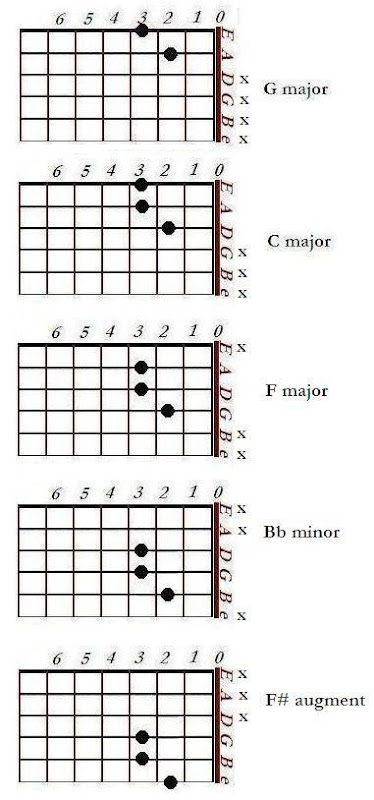On the guitar neck, many chords share similar shapes and are played at the same position from the nut, though they may be completely different. To paraphrase, the finger arrangement used to play a chord shape in a particular position need not be altered (at all / very much) to play a different chord in that very same position. Merely by shifting the entire hand literally up or down (vertically) at a position (and not along the guitar neck), we can play such chords.
Let us go through the method that would be used in order to derive these relations:
- We seek to derive common denominator shapes of chords to aid understanding of the structures and learn them
- We may modify the number of strings played in a chord at a time during this exercise, to exclude unwanted notes, playing at least 3 notes at a time (to form chords).
- We may play partial shapes to accentuate the relationships and preserve the basic common shape we seek to derive.
- This exercise is not intended to describe the "common" chord shapes. Rather, it tries to derive spatial dispositions of individual chords with respect to one another starting from common shapes.
- We may play inverted chords, instead of straight-cut ordered triads to obtain relations
- We may reduce the number of strings played to a minimum in this exercise in order to ensure transposability of the series
- You may choose to play the partial 3 string format (triad) or you may choose to complete the chord shape and play the full shape, using the above series as a map only.
Things will be clearer with aid of the examples provided. This is an especially important conjecture with respect to chord changes as well as understanding the note layout along the neck. Understanding this will aid you in learning, remembering and finally mastering many common chords, as well as uncommon shapes of common chords. These transformations are especially important to bassists, who tent to play fewer strings - the bass has only four.
Examples:
Modified C major (x32010), G major (320033) and E major (022100) shapes and their vertical transforms:

- G major : 320xxx
- C major : 332xxx (C major 2nd inversion, instead of x320xx)
- F major : x332xxx
- Bb minor : xx332x (Bb minor in 2nd inversion)
- F# augmented : xxx332 (F# augmented in 2nd inversion).
The above series goes through 5 different chords, all containing a similar shape. Some have had to be slightly modified or inverted, but the relationship still holds. The pattern that has become apparent is that, the series uses 2nd inversion chords to fill in for the uninverted ones. It also connects the G major, C major and E major shapes, as well as the A minor (as Bbm) and the augmented (F#+) shapes of the CAGED system. Again, if the G major shape of the series be dropped (or be reduced to only an interval by playing 32xxxx), the whole thing becomes transposable up and down the neck. For example, if moved a semitone towards the nut, the series gives:
{F#-A# interval} -> B major -> E major -> A minor -> F augmentAgain, if moved down to, say the position of A major in 5th position, we get:
{B-D# interval} -> E major -> A major (in 5th position) -> D minor -> Bb augmented.Analyzing using Roman numeral notation using the 2nd chord as I (i.e. taking C major as I), we get the following pattern (ignoring the invention status of chords) :
V - I - IV - b vii - b V+
The first three of the series would be useful in playing modal progressions such as I-IV-V-I.
Modified A major in root position (x00220) shape and its vertical transforms:
- E sus2 / B sus4 : 222xxx (as 2nd inversion)
- A sus2 / E sus4 : x222xx (as inversions)
- A major : xx222x (in root position)
- F#m : xxx222 (as 1st inversion)
Modified D major in root position (xx0232) and its vertical transforms:
- E diminished : xx232x (This is the diminished triad Xo / X dim. Adding the interval of a diminished seventh to it turns it into the dim7th chord, xx2323, commonly mislabeled as just "diminished")
- D major : xxx232
Modified D minor in 1st position (xx3231) and its vertical transforms:
- C diminished : 231xxx (inverted)
- F diminished : x231xx (inverted)
- A part of C7th : xx231x (C7 will be xx2313 - often played as x32310)
- D minor : xxx231 (inverted)
Many more may be possible, but the idea of the exercise was to provide the basic insight.
http://basicmusictheory.blogspot.com/2011/08/vertical-relationship-between-chord.html
Liked 'Vertical Relationship Between Chord Shapes' enough to share / save?
Comments: 0 comment(s)...have your say!
Post your comment!